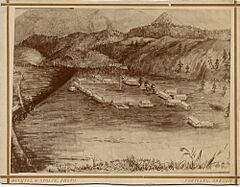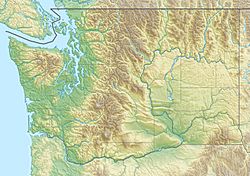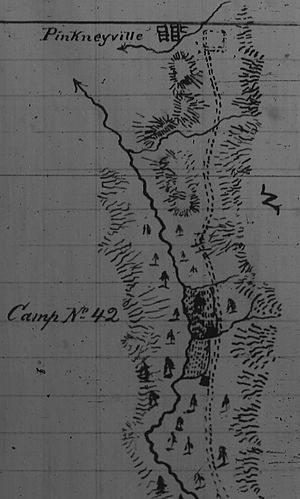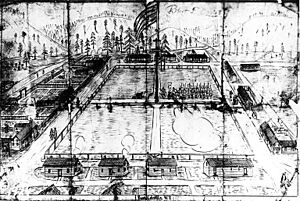Fort Colville facts for kids
Quick facts for kids Fort Colville |
|
|---|---|
| Near Colville, Washington in United States | |
 |
|
|
Location in the United States##Location in Washington
|
|
| Coordinates | 48°34′19″N 117°52′44″W / 48.57194°N 117.87889°W |
| Site information | |
| Owner | United States Army |
| Site history | |
| Built | December 19, 1859 |
| In use | 1859–1882 |
| Materials | Timber |
| Fate | Abandoned in 1882 |
| Garrison information | |
| Past commanders |
Pinkney Lugenbeel (1859–1861) James F. Curtis (1861–1862) William R. Abercrombie (1871–1872) |
Fort Colville was a U.S. Army base in the Washington Territory. It was located about 3 miles north of the modern town of Colville, Washington. From 1859 to 1882, it was known by different names. These included "Harney's Depot" and "Colville Depot" before it was finally called "Fort Colville."
In 1858, Brigadier General William S. Harney ordered the area north of the Snake River to be opened for settlers. He also told Brevet Major Pinkney Lugenbeel to build a military post. This fort was meant to keep peace with Native American tribes. It also protected miners who came to the area after gold was discovered in 1855.
The soldiers often used existing Native American trails to create military roads. They only made changes needed for moving cannons or supplies. Major Lugenbeel followed an old Hudson's Bay Company trail from the Fort Walla Walla area. However, he had to leave the trail near modern-day Orin-Rice Road. This was because the Hudson's Bay Company owned the land further south. The U.S. government had to respect these land claims. The road became known as the Fort Walla Walla Fort Colville Military Road. Lugenbeel's troops arrived from Fort Walla Walla on June 20, 1859.
Major Lugenbeel was also put in charge of Native American affairs near Fort Colville. After he left, a civilian Indian agent took over. In 1869, U.S. President Ulysses S. Grant and Congress created the Board of Indian Commissioners. This was to reduce corruption in how Native American affairs were handled. By 1872, the Indian agent for tribes like the Colville, Sinixt, Sanpoil, Syilx, Spokane, and Pend d'Oreilles moved from the fort to Chewelah, Washington.
Contents
Building the Fort: A New Home for Soldiers
Major Lugenbeel was told to build a fort big enough for 300 soldiers. It also needed space for the U.S. Northwest Boundary Commission staff. A sawmill nearby charged too much for lumber. So, Lugenbeel built a sawmill for the fort on Mill Creek. This helped keep building costs low.
The U.S. Northwest Boundary Survey team arrived at the fort on December 3, 1859. But their assigned buildings were not ready. Temperatures dropped to -22°F, so they stayed in tents until December 19. The new buildings were strong and warm. The survey team lived there for two years. They worked on mapping and clearing the border along the 49th parallel to the Rocky Mountains.
A small town called Pinkney City, Washington grew up outside the fort. It was named after Major Lugenbeel's first name. In 1860, Pinkney City became the first county seat for Spokane County, Washington. When Spokane County and Stevens County, Washington joined in 1864, it remained the county seat for Stevens County. From 1860 to 1864, Spokane County used the fort's jail for holding prisoners.
On September 28, 1860, First Lieutenant August V. Kautz arrived at Fort Colville with 150 new soldiers. His diary described the route from Coeur d'Alene to the fort. It followed a road built by the U.S. Northwest Boundary Commission.
Fort Colville During the Civil War
When the American Civil War began in 1861, army officers had to promise their loyalty again. Four officers at the fort resigned to join the Confederate States of America. As the war started, Major Lugenbeel was ordered to take his soldiers to Fort Walla Walla in November 1861. Volunteer soldiers replaced them at Fort Colville.
Volunteer Soldiers Take Over
In late 1861, Companies C and D of the 4th California Infantry Regiment took over the fort. Some locals thought these troops were difficult.
On July 11, 1862, Companies B and C of the 1st Regiment Washington Territory Volunteer Infantry took command of the fort.
On May 26, 1865, one company from the 1st Oregon Volunteer Infantry Regiment took over the fort.
Regular Army Troops Return
On November 3, 1865, regular U.S. Army troops returned. Company G of the 14th Infantry Regiment took over the fort. On February 18, 1867, soldiers from Company G were involved in a serious incident at a local saloon.
On May 6, 1867, Company G of the 23rd Infantry Regiment became responsible for the fort.
On February 10, 1869, Company D, 23rd Infantry, took over guarding the fort.
On June 10, 1872, Company E of the 21st Infantry Regiment took over the fort.
Cavalry Troops Arrive
In 1875, cavalry troops were assigned to Fort Colville for the first time. Company M of the 1st Cavalry Regiment joined Company E. New buildings were added to the fort for horses. In 1876, ongoing Native American unrest in the Montana Territory showed the fort was still needed. In 1877, many soldiers from Fort Colville helped chase and fight the Nez Perce.
On October 21, 1880, Fort Spokane was built by the U.S. Army. It was located where the Columbia and Spokane Rivers meet. Cavalry often stayed at Fort Colville because there wasn't enough hay and grain around Fort Spokane until 1885.
One of the last missions from the fort was First Lieutenant Henry H. Pierce's trip. He traveled from Fort Colville to Puget Sound, Washington Territory. This journey, in August and September 1882, went through Lake Chelan and along the Skagit River.
Nine months after the soldiers left, Commanding General of the United States Army William Tecumseh Sherman visited Fort Colville. This was in August 1883, during a tour of Army posts in the west.
Fort Colville Closes Down
Fort Colville was officially closed in 1882. On September 11, 1929, leaders in Colville dedicated a monument to the fort.
The bodies of soldiers who died at the fort were later moved. They were reburied at the Presidio of San Francisco and the San Francisco National Cemetery. Any soldiers who stayed in the area are likely buried at the Evergreen Cemetery. This cemetery was started in 1868, just west of the old fort.
People Connected to Fort Colville
Many interesting people were associated with Fort Colville:
- In 1859, Captain John Mullan visited to check on the Fort Walla Walla Fort Colville Military Road. He was planning to build the famous Mullan Road.
- First Lieutenant John Grubb Parke was a key scientist for the U.S. Northwest Boundary Commission in 1859. He later became a general in the Civil War. He also served as the Superintendent of the U.S. Military Academy.
- Captain John Wesley Frazer helped build Fort Colville in 1859. He later became a Brigadier General for the Confederacy.
- Joseph Smith Harris was part of the U.S. Northwest Boundary Commission. He was stationed at the fort from 1859 to 1861.
- Second Lieutenant Charles Garrison Harker was part of the escort for the U.S. Northwest Boundary Commission in 1859. He became a U.S. Army brigadier general in the Civil War.
- Captain James J. Archer protected the U.S. Northwest Boundary Commission and served at the fort. He also became a Brigadier General in the Confederate Army.
- Major James Freeman Curtis commanded two companies of the 4th California Infantry Regiment. He later became the Idaho Secretary of State.
- Captain Moses Harris, who commanded the fort from 1875 to 1878, received the Medal of Honor during the Civil War.
- First Lieutenant William R. Abercrombie commanded the fort in 1871. Later, Fort Abercrombie, Alaska was named after him. So was Abercrombie Mountain in Stevens County.
- George Washington Goethals visited Fort Colville in 1883. He later directed the building of the Panama Canal.
- Major William F. Drum was the last commander of Fort Colville in 1882.
- John U. Hofstetter was a soldier at the fort when it was built. He later became a Spokane and Stevens County Commissioner and Sheriff. He was also a founder of the City of Colville.







